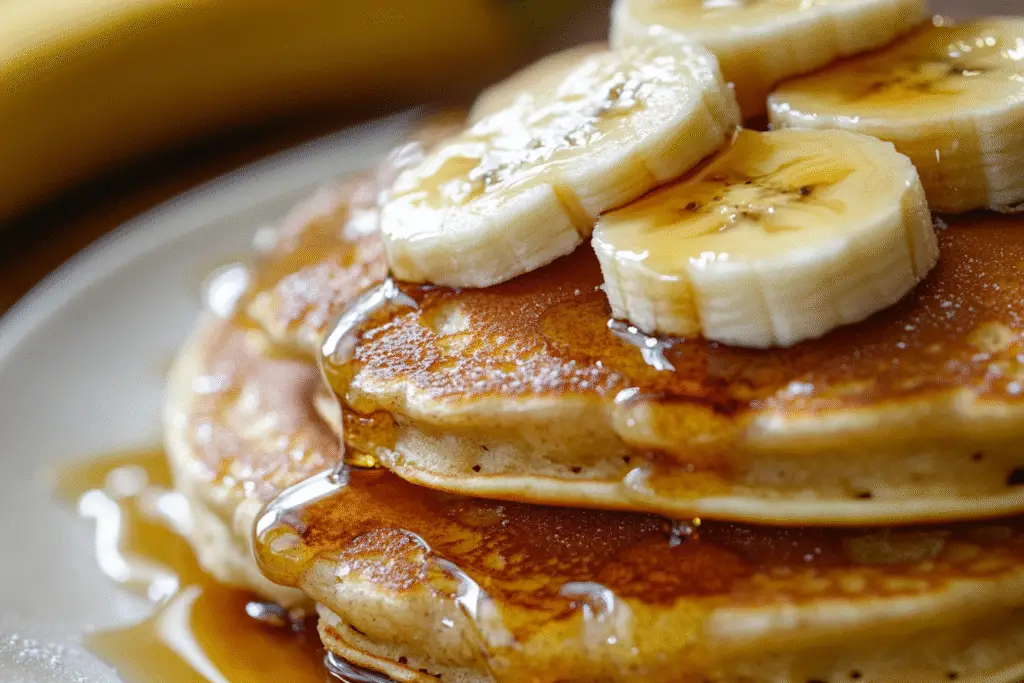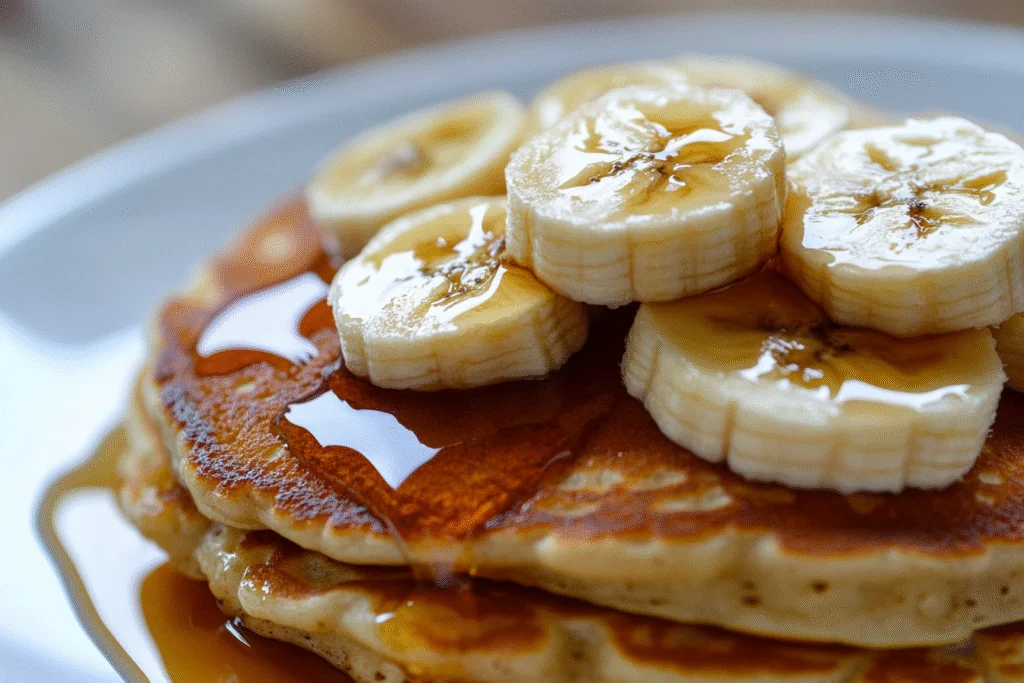Introduction
Brown Sugar Banana Pancakes are the perfect marriage of cozy, caramelized sweetness and soft, fluffy texture. The bananas bring natural moisture and a tender crumb, while the brown sugar adds a rich, molasses-like depth that transforms ordinary pancakes into something genuinely memorable. Whether you’re trying to use up overripe bananas, seeking a comforting weekend breakfast, or simply looking to spice up your pancake routine, these Brown Sugar Banana Pancakes are destined to become a family favorite.
In this deep dive, we’ll explore every detail you need to master this recipe. From selecting the perfect bananas to troubleshooting common pancake pitfalls like gummy centers or uneven cooking, this guide will equip you with the tools and tips to make picture-perfect pancakes every time. We’ll also cover flavor enhancements, equipment essentials, substitution options, and more to make this recipe as versatile and foolproof as possible.
Choosing the Perfect Bananas and Ingredients
The star ingredient here is, of course, the banana. For the best flavor and texture:
- Use overripe bananas. The peels should be heavily speckled with brown spots or even mostly brown. These bananas are at their sweetest and softest, which makes them ideal for mashing into the batter.
- Brown sugar: Light or dark brown sugar both work. Dark brown sugar will deliver a stronger molasses flavor, while light brown sugar offers a more subtle caramel note.
- Flour: Standard all-purpose flour provides the best structure. For gluten-free options, you can use a 1:1 gluten-free baking flour.
- Milk: Whole milk is preferred for a rich batter, but dairy-free alternatives like almond or oat milk can substitute well.
- Fat: Melted butter or neutral oils like canola or coconut oil will keep the pancakes tender and prevent sticking.
- Leaveners: Baking powder and a touch of baking soda give these pancakes their lift and help balance the banana’s moisture.
- Egg: Essential for binding the batter and adding structure.

Equipment Essentials
To achieve evenly cooked, golden-brown pancakes, having the right equipment makes a huge difference:
- Non-stick or cast-iron skillet: These help ensure pancakes cook evenly and flip cleanly.
- Griddle: If making large batches, a griddle provides consistent heat across a larger surface.
- Spatula: A thin, wide spatula is perfect for flipping without breaking the pancakes.
- Mixing bowls: You’ll need separate bowls for wet and dry ingredients to avoid over-mixing.
- Measuring cups and spoons: Accurate measurements are key to balanced batter.
Common Pancake Problems and How to Solve Them
- Dense pancakes: This usually happens when the batter is over-mixed. Stir just until the flour is incorporated to keep the batter light.
- Undercooked centers: Cook over medium to medium-low heat to allow the pancakes to cook through without burning the outsides.
- Banana lumps causing uneven cooking: Fully mash bananas until smooth or leave small chunks if you prefer texture but ensure they’re evenly distributed to prevent raw pockets.
- Pancakes sticking: Always preheat your skillet and use enough butter or oil to coat the cooking surface thoroughly.
Flavor Enhancements and Creative Add-ins
While brown sugar and banana are a stellar combination on their own, you can easily customize these pancakes to suit your tastes:
- Spices: Cinnamon, nutmeg, or allspice can be added to the dry ingredients for a warm, spiced flavor.
- Vanilla extract: Adds a lovely aromatic note that pairs beautifully with bananas.
- Add-ins: Chopped walnuts, pecans, or chocolate chips can be folded into the batter for extra texture and flavor.
- Toppings: Sliced bananas, caramel sauce, maple syrup, or a dollop of whipped cream elevate the pancakes from comforting to luxurious.
Preparation Tips for Best Results
- Use room-temperature wet ingredients: This helps the batter come together smoothly and promotes even cooking.
- Let the batter rest: Allowing the mixed batter to rest for 5–10 minutes before cooking lets the flour fully hydrate and the leaveners activate.
- Cook over medium heat: Too high a temperature can burn the pancakes before the centers cook through.
- Don’t press down: After flipping, avoid pressing on the pancakes as this deflates them and can make them dense.
Substitutions and Dietary Adjustments
- Gluten-free: Use a 1:1 gluten-free flour blend.
- Dairy-free: Substitute almond, soy, or oat milk and use coconut oil instead of butter.
- Egg-free: Use a flax egg (1 tablespoon ground flaxseed mixed with 3 tablespoons water, let sit 5 minutes) or a commercial egg replacer.
- Sugar-free: Replace brown sugar with coconut sugar or a sugar substitute like monk fruit sweetener.

Ingredients
Dry Ingredients
- 1 1/2 cups (180g) all-purpose flour
- 2 tablespoons light or dark brown sugar
- 1 tablespoon baking powder
- 1/2 teaspoon baking soda
- 1/4 teaspoon salt
- 1/2 teaspoon ground cinnamon (optional)
Wet Ingredients
- 2 medium overripe bananas (about 1 cup mashed)
- 1 cup (240ml) whole milk (or plant-based milk)
- 1 large egg
- 2 tablespoons unsalted butter, melted (plus more for cooking)
- 1 teaspoon vanilla extract
Optional Add-ins
- 1/3 cup chopped walnuts or pecans
- 1/3 cup mini chocolate chips
Optional Toppings
- Sliced bananas
- Maple syrup
- Whipped cream
- Caramel sauce
Step-by-Step Instructions
1. Prepare the Batter
- In a large bowl, whisk together flour, brown sugar, baking powder, baking soda, salt, and cinnamon (if using).
- In a separate bowl, mash the bananas until mostly smooth.
- Add milk, egg, melted butter, and vanilla extract to the bananas and whisk until well combined.
- Pour the wet ingredients into the dry ingredients and stir gently until just combined. The batter should be thick and lumpy; do not over-mix.
- If using, gently fold in nuts or chocolate chips.
- Let the batter rest for 5–10 minutes while you preheat your pan.
2. Preheat the Skillet
- Heat a non-stick skillet or griddle over medium heat.
- Lightly grease the surface with butter or oil.
3. Cook the Pancakes
- Scoop about 1/4 cup of batter per pancake onto the hot skillet, spacing them a few inches apart.
- Cook for 2–3 minutes per side, or until bubbles form on the surface and the edges begin to look set.
- Flip gently and cook for another 2–3 minutes, until golden brown and cooked through.
- Adjust heat as necessary to prevent burning before the pancakes cook through.
4. Serve Warm
- Stack the pancakes on plates and top with sliced bananas, a drizzle of maple syrup, whipped cream, or caramel sauce as desired.
- Serve immediately for the best texture.
Troubleshooting Tips
- Pancakes browning too quickly: Lower the heat to give the inside time to cook properly.
- Pancakes sticking: Make sure the pan is properly greased and fully preheated before adding batter.
- Lumpy batter: Some lumps are fine, but ensure dry flour pockets are fully mixed in to avoid gummy spots.
- Too thick batter: Add a tablespoon or two of milk if the batter seems overly thick.
Storage and Reheating
- Storage: Leftover pancakes can be stored in an airtight container in the refrigerator for up to 3 days.
- Freezing: Layer pancakes between sheets of parchment paper and freeze in a zip-top bag for up to 2 months.
- Reheating: Warm pancakes in a toaster, microwave (20–30 seconds), or oven at 300°F (150°C) for 8–10 minutes.
Serving Suggestions
- For a simple breakfast: Serve with maple syrup and sliced bananas.
- For indulgence: Top with caramel sauce, whipped cream, and chopped nuts.
- For variety: Add chocolate chips to the batter and serve with chocolate sauce or Nutella.
- For a brunch spread: Pair with crispy bacon, scrambled eggs, and fresh fruit salad.
Variations: Classic vs. Banana vs. Brown Sugar Banana Pancakes
- Classic Pancakes: Typically use granulated sugar and no fruit in the batter.
- Banana Pancakes: Focus on banana as the sweetener and moisture source, often using white sugar or no sugar.
- Brown Sugar Banana Pancakes: Combine the deep caramel flavor of brown sugar with bananas for a richer, more layered taste and a moist texture.
Dietary Substitutions Summary
| Ingredient | Substitution |
|---|---|
| All-purpose flour | 1:1 gluten-free flour blend |
| Whole milk | Almond, oat, or soy milk |
| Egg | Flax egg or egg replacer |
| Butter | Coconut oil or vegan butter |
| Brown sugar | Coconut sugar or monk fruit |
Let me know if you’d like another recipe!
